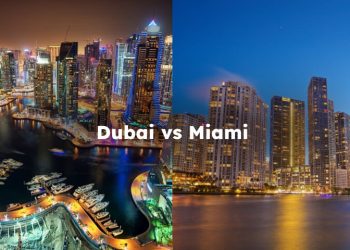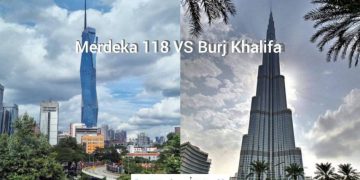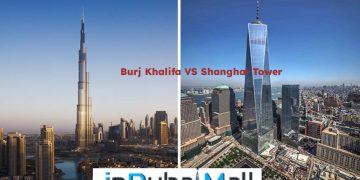In recent years, improvements in construction materials and techniques have enabled buildings to rise higher. When we consider how architects and engineers apply aerodynamics and their enhanced knowledge of aviation, we can anticipate that future skyscrapers will reach new heights. Currently, many architects dream to build a skyscraper that could rank among the tallest in the world. In this article on Indubaimall, we will take a look at Burj Khalifa vs Shanghai Tower.
Most important differences between Burj Khalifa and Shanghai Tower
The Burj Khalifa is a remarkable example of human creativity and architectural skill, proudly recognized as the tallest building in the world. It serves as a symbol of modern engineering and it represents Dubai’s swift evolution into a global metropolis, while it was frequently mentioned in comparisons of Burj Khalifa vs Other Buildings because of its unmatched height and design. This skyscraper has changed the definition of tall buildings, establishing new benchmarks for future projects. Let’s delve into the different aspects that contribute to the most important aspects of Burj Khalifa vs Shanghai Tower.

Height and record-breaking
Finished in 2010, the Burj Khalifa covers an area of 2 km2 in downtown Dubai. Burj khalifa vs shanghai tower height standing at 828 meters tall, and it is one of the tallest structures globally and currently holds the record for the tallest building in the world. It was designed by the architectural firm Skidmore, Owings and Merrill from Chicago. This building includes the highest observation deck and elevator in the world, as well as the highest restaurant and nightclub. The Shanghai Tower, that was built in Shanghai, China, was finished in 2015 and it reaches a height of 632 meters.
Floors and usable space
Among all built structures, Burj Khalifa has the most floors, and it is totaling 163, which include residential and office areas, restaurants, shopping malls, and high-end hotels. Made from reinforced concrete, aluminum, and steel, the building contains more than 24,000 windows. In contrast, the Shanghai Tower, that is a 128-story building, offers office spaces, concert venues, and a swimming pool located on the 84th floor. Although the Shanghai Tower is not the tallest building globally, but it is known for having the highest usable floor height. Its observation deck, that is located at 562 meters, shares the record for the highest observation deck in the world.
Construction cost and timeline
The Burj Khalifa in Dubai and the Shanghai Tower in China are two of the world’s most iconic skyscrapers, but they differ in construction timelines and costs. The Burj Khalifa’s construction began in January 2004, with exterior completion by late 2009 and its grand opening in January 2010, while it is meaning it took about six years to complete. Burj Khalifa vs shanghai tower cost is estimated at around US$1.5 billion, and it is reflecting both the speed of development and Dubai’s drive for a global landmark. In contrast, the Shanghai Tower broke ground in November 2008 and officially opened in February 2015, while it was taking roughly seven years. Its cost reached about US$2.4 billion, significantly higher than the Burj, largely because of its advanced green technologies, double-skin façade, and mixed-use design catering to offices, hotels, and public spaces. While the Burj Khalifa holds the title of the tallest building, the Shanghai Tower emphasizes sustainability and futuristic engineering.
Here is the table of Burj Khalifa vs Shanghai Tower in construction cost and timeline:
| Feature | Burj Khalifa (Dubai) | Shanghai Tower (Shanghai) |
| Timeline | 2004 – 2010 (6 years) | 2008 – 2015 (7 years) |
| Construction Cost | $1.5 billion | $2.4 billion |

Engineering and design
The building of Burj Khalifa vs Shanghai Tower lasted nearly six years, involving 10,000 workers and 330 engineers. Adrian Smith from the Chicago architectural firm Skidmore, Owings & Merrill (SOM) designed the project. It required teamwork among architects, engineers, and construction crews. The whole process was meticulously organized with advanced technology and vast knowledge that it can tackle any challenges that might arose. The Burj Khalifa was created with advanced features for safety and stability. Its Y-shaped design and three-lobed base help lessen wind pressure, while strong reinforced concrete and steel offer great load support. The foundation is robust enough to hold the building’s high weight that is 250,000 tons.
The Shanghai Tower, that was created by Gensler with Jun Xia as the main architect, is a remarkable engineering feat that causes a beauty, sustainability, and innovative structure. Its twisted, double-layer glass exterior decreases wind pressure by 24% and improves energy efficiency. Constructed with a strong concrete core, large columns, and outrigger trusses, it endures both wind and earthquake forces. With vertical sections that include atriums, rainwater recycling, and wind turbines, the tower has earned LEED Platinum certification, while it is representing a sustainable design for supertall buildings.





















